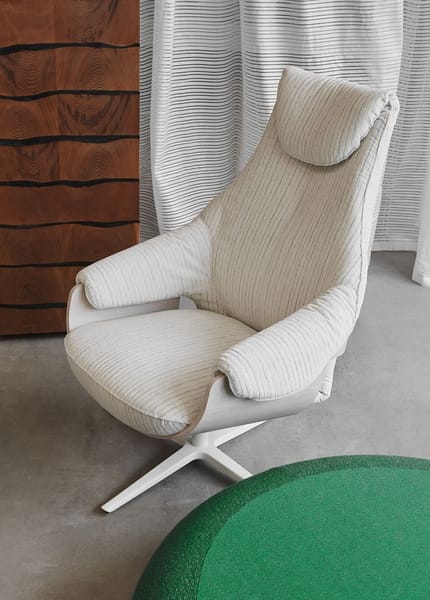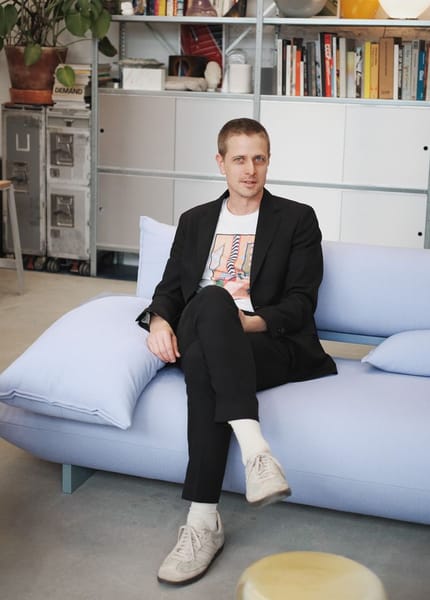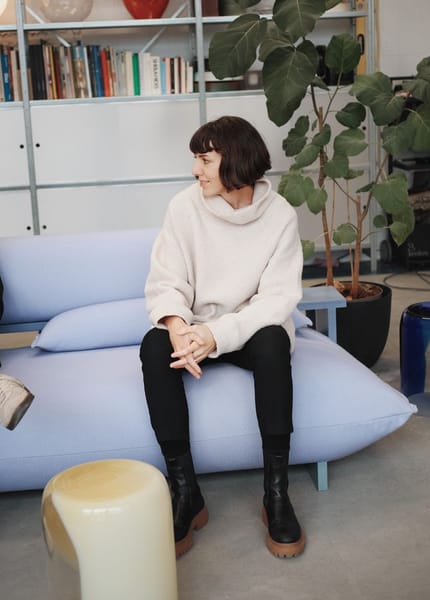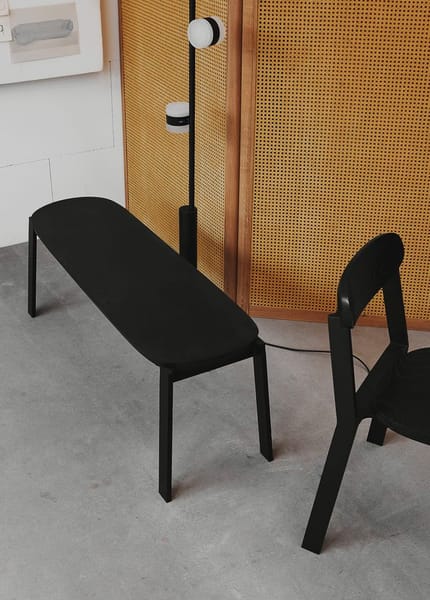Studio Portrait – On Office Magazine
December 2020
Words by Alice Morby
Photography by Michèle Margot
Working together comes naturally for married couple Kate and Joel Booy of Studio Truly Truly – in a design trajectory that has led to their new role as art directors with Leolux.
In recent months, working with our partners and families has become something of a bizarre norm. Kitchens have been turned into abstract soundscapes of concurrent Zoom calls, while bedrooms have stepped in for boardrooms. Our professional and personal lives have become entwined in a way many of us have never experienced before. But for Kate and Joel Booy of Studio Truly Truly, it’s something seemingly integral to their process. Having met at university, the couple has worked together for their entire professional life thus far.
“I think the combination of our skills and personalities is what makes it work,” says Joel, as the pair sit side by side in their Rotterdam studio.
“Your ideas process is very passionate,” Kate adds. “You get this one idea and you’re very hooked on it, whereas I’m much more analytical. I make a million drawings and I like exploring every possibility. But we’ll talk about them together, and sometimes that leads somewhere great.”
Historically, romantic partnerships have been the key to creative success, so much so that London’s Barbican Centre dedicated its Modern Couples exhibition in 2019 to the many great, inimitable, and sometimes rather tragic, couples that, together, have made a mark on the history of art and design. Following in the footsteps of the likes of Aino and Alvar Aalto and Ray and Charles Eames, it looks like Kate and Joel could be on to a good thing.
Both Kate and Joel were born in Australia in 1981, Kate one hour north of Brisbane and Joel one hour west. They describe their childhoods as being complete opposites, with their respective experiences ultimately contributing to who they are as people.
Joel was immersed in his parents’ furniture business, and would spend his weekends at the workshop surrounded by materials, “while making bucks washing the cars of my mum and dad’s employees with my sister,” he adds.
“I was raised around furniture, and my parents had stuff like Mario Bellini’s Cassina chairs in the house, but I wasn’t interested in it at all,” he says.
He describes his father as a “maverick” who was very much the business person in the partnership, while his mother was the force behind the design. “I think that character of your dad has carried through to you a bit,” Kate says. “You’re not afraid to try anything, whereas I’m a bit more level-headed.”
Kate credits her ability to be the voice of reason within her own partnership to her supportive and encouraging childhood. Her father worked in the government and her mother as a teacher, but both were art hobbyists and, as such, creativity was fostered throughout her childhood.
Having both lived in the suburbs throughout their early and teen years, the pair met when they enrolled on the Graphic Design and Typography course at Queensland College of Art in 1999. After they graduated (Kate took a minor detour for a period of travelling), they both ended up as designers at Brisbane studio Inkahoots, where they spent the next phase of their careers.
“Inkahoots is essentially a socialist studio,” Joel says. “The structure of the studio is set up so that the people who have been there for 20 years and started the place get paid exactly the same as you when you start your job.”
The studio’s radical structure is echoed in the work it creates, which mainly involves the community and cultural sectors. Describing itself as not fitting into “the usual industry moulds”, which it admits is both a help and a hindrance in terms of business, Inkahoots started out as a collective of community artists and has transformed itself into a multidisciplinary studio. “We actually often had pretty low budgets,” Joel says, “but it made you super creative with the outcome of the story that you were selling.” “It makes you get better at being able to design, because you’ve got less to work with,” Kate adds.
After almost a decade working as a graphic designer, however, Joel began to grow weary of the discipline. Wanting something more from his work, he began researching master’s programmes that would combine the pair’s desire to travel to Europe.
Having settled on Design Academy Eindhoven in the Netherlands, they left their home country for Utrecht, moving into their apartment overlooking the canal. Joel would commute into Eindhoven for classes, and would then return home to work on his projects late into the night, enlisting the help and expertise of Kate. “It was crazy going back to student lifestyle again,” she says, recalling a particular project deadline when Joel was cutting plasterboard in the living room.
Adapting to the Dutch culture was easy, and the pair fitted in right away. But the biggest shock, they say, came from the age disparity between them and their peers. “Everyone was 10 years younger than us!” Joel says. “We were just restarting our careers, so it was a big switch to be thrown back into the student lifestyle,” adds Kate.
Design Academy Eindhoven was founded in 1955, and has produced some of the world’s most successful designers, such as Maarten Baas, Wieki Somers and Hella Jongerius, who went on to become a mentor to the pair for a project at the TextielMuseum. Its interdisciplinary approach to design education has earned it an international reputation, attracting students from all corners of the globe.
Across the duration of their four years at the school, students are free to move across eight studios that each reflect a different perspective and position, but they all graduate with the same degree – a Bachelor of Design.
Despite Joel being the one doing the degree, Kate says that a process of “osmosis” equipped her with the skills and knowledge to go on to developing thinking about design in a more three-dimensional sense.
“We would talk about absolutely everything that Joel was doing, because we’re in the habit of doing that anyway,” she recalls. “We started developing our own language about 3D design, and we can both imagine what each other is talking about really easily.”
It’s a formula that seems to be working, as the pair have come a long way since that point. In June of this year, they were announced as the new art directors of Dutch brand Leolux, which had its heyday in the 1980s and 90s but had largely remained a quiet staple on the scene in recent years. They see their new role as art directors as a culmination of the skills they have developed over the years, both in graphic and 3D design, and plan to “build on the Leolux story” using their studio’s core principles: an attention to detail, use of colour and a focus on materiality.
Upon the announcement of their new posts at Leolux, the brand unveiled two pieces by Studio Truly Truly: the Cream armchair, made with a wooden plywood shell in walnut or oak and upholstered in a soft fabric or leather; and the Klaar occasional table, which was made in collaboration with the Dutch Glass Museum in Leerdam, and sees each glass table handblown – resulting in a unique patina each time.
Leolux came across the work of Kate and Joel at the 2019 edition of IMM in Cologne. The duo had been asked to design the fair’s main attraction, Das Haus, which every edition showcases an emerging designer’s personal vision of contemporary domestic living.
For their turn, the designers opted to create spaces that reflected atmospheric moods as opposed to defined functions. Inside, they showcased new prototypes alongside old classics, and combined useful lighting and accessories with standout design objects and art pieces.
They devised a number of prototypes especially for the exhibition, which showcased the breadth and totality of their ability. For the kitchen, they created a multi-levelled island, tiled in brightly glazed yellow lavastone that contrasts with its stainless-steel legs. A sofa named Press features a bold wooden frame that causes the voluminous cushions to bulge in natural curves which exaggerate comfort and softness, while the Ostinato bed, now produced by Mast Furniture, is made from warm-coloured wood and features a sculptural shelf that works as a bed foot or head.
“It’s been hard and fast, but now we’re getting to the point where we spend more time on every project we do.”
All in all, Das Haus certainly seemed a pinnacle moment in the journey of Studio Truly Truly. They credit their big start in the furniture world to a commission from IKEA in 2014, which came about after the company paid a visit to their studio, at a time when they were both preoccupied with Joel’s graduation project – “We just we had this tiny space and all of a sudden it was full of 20 or 30 IKEA staff ready to hear what’s going on,” he recalls.
A successful visit, the pair ended up with a textile design commission for the company’s PS collection, shortly followed by a sofa for Ikea PS 2017.
As with most young design studios, there was an element of hand-to-mouth in the early years, which, somewhat refreshingly, Kate and Joel don’t shy away from speaking about. But being the polymaths that they are, the duo were able to put their hand to a number of different projects, using their experience in graphic design to pay the bills, as well as creating exhibition designs for a number of clients, including the Dutch Invertuals collective led by curator Wendy Plomp, which shows at Milan and Dutch Design Week each year and presents works that address the future of the industry.
“The thing about the Design Academy is that they teach you to learn your own fascination,” Joel says. “It becomes your source to start from, no matter the project. You just have to have a driving force as to why you’re doing what you’re doing.” “It’s a case of building a gut instinct for projects, and knowing what’s right and wrong,” Kate adds.
With collaborations with the likes of Kvadrat, Rakumba, MRM Objects, Ikea and the TextielMuseum under their belt, what’s next?
“There’s been a jump with the kind of companies we’ve been speaking to in the last year or so, but there’s still so much growth to do,” Kate says. “Things have snowballed for us, and it’s great, but in terms of what we’d like to do next, we’d like to spend more time honing our craft.”
“It’s been hard and fast, but now we’re getting to the point where we spend more time on every project we do,” Joel adds. “With more time for things, you also consider how to do it better, and we want to work towards to being sustainable in the right way.”
With the world having slowed down of late, it seems like the perfect moment for a change of pace, at least for a while.



